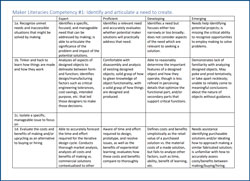MAKER COMPETENCIES
 Competencies, Rubrics, and Frameworks
to assist in selecting and utilizing the Maker Literacies (Download PDF)
Competencies, Rubrics, and Frameworks
to assist in selecting and utilizing the Maker Literacies (Download PDF)
The “Maker-Literate” student can:
1. Identify and articulate a need to create.
- 1a. Recognize unmet needs and inaccessible situations that might be solved by making
- 1b. Tinker and hack to learn how things are made and how they work
- 1c. Isolate a specific, manageable issue to focus on
- 1d. Evaluate the costs and benefits of making and/or upcycling as an alternative to buying or hiring
2. Analyze and explore ideas, questions, problems, and potential solutions.
- 2a. Define an idea, question, and/or problem
- 2b. Break an idea, question, and/or problem into its constituent parts for closer analysis
- 2c. Investigate how others have approached similar situations
- 2d. Question assumptions
- 2e. Brainstorm a variety of solutions and pursue the most promising
3. Create effectively and safely.
- 3a. Seek training, information, and necessary certifications when planning to work with dangerous equipment and materials
- 3b. Wear personal protective gear when appropriate
- 3c. Reinforce safety precautions with others
- 3d. Accustom self with location-specific emergency procedures, egress and disaster plans
- 3e. Transfer safety principles covered in training to real-world contexts
4. Assess the availability and appropriateness of tools and materials.
- 4a. Research various equipment and materials to determine limitations and suitability for specific applications
- 4b. Consider environmental sustainability/impact when making, including upcycling and recycling materials
- 4c. Determine the most ideal tools, materials, and method(s) of creation (physical, digital, and rhetorical) for the project
- 4d. Secure access to the necessary tools, materials, and space/facilities
- 4e. Investigate alternatives when a desired tool or material is not available or is too resource intensive
- 4f. Fabricate necessary tools, reimagine material choices, develop alternate workflows, and/or revise project scope when tools or materials are not feasible
5.Prototype using iterative design principles.
- 5a. Specify measurable criteria for a successful prototype vs desired finished product
- 5b. Divide design into individual components to facilitate testing
- 5c. Take intelligent risks, use trial and error, and learn from failures
- 5d. Test measurable criteria to determine whether creation meets needs
- 5e. Gather prototype feedback and input from stakeholders and mentors
- 5f. Revise and modify prototype design over multiple iterations
6. Develop a project management plan.
- 6a. Specify actionable and measurable project goals and requirements
- 6b. Utilize time management and project management tools
- 6c. Outline project milestones, including sequential action items and anticipating time for multiple prototype iterations
- 6d. Work effectively within project constraints, be they financial, material, spatial, and/or temporal
7. Engage in effective teamwork.
- 7a. Gauge the costs & benefits of “Doing-it-Yourself” (DIY) or “Doing-it-Together” (DIT)
- 7b. Recognize opportunities to collaborate with others who provide diverse experiences and perspectives
- 7c. Recruit team members with diverse skills appropriate for specific project requirements
- 7d. Join a team where one’s skills are sought and valued
- 7e. Listen and communicate attentively to learn from and with others
- 7f. Follow through on commitments and contribute to culture of accountability
8. Employ effective knowledge management practices.
- 8a. Restate technical and maker jargon for the layperson
- 8b. Document steps clearly with sufficient detail for others to follow and replicate workflows
- 8c. Use version control to manage project outputs and documentation
- 8d. Preserve project outputs and documentation for long-term access
9. Apply knowledge gained into other situations.
- 9a. Teach skills and share insights with other makers
- 9b. Recognize and cultivate transferrable skills
- 9c. Transfer knowledge, skills, and methods of inquiry across disciplines and activities
- 9d. Familiarize self with skillsets of others
- 9e. Connect those seeking to learn something with those who have relevant experience
10. Understand ethical and intellectual property issues surrounding making.
- 10a. scrutinize the ethical implications of making
- 10b. demonstrate an understanding of intellectual property rights and protections
- 10c. weigh the costs & benefits of seeking intellectual property protections v. making project outputs open and freely available to others
- 10d. examine the potential viability of both proprietary and open source systems to adopt/adapt
- 10e. respect the intellectual property rights of other makers